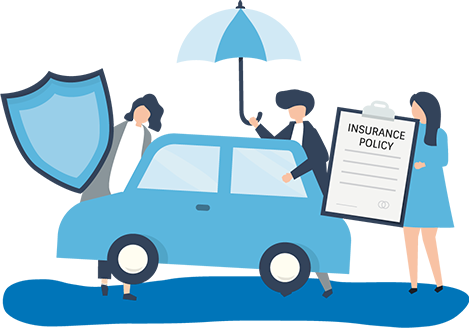
Whenever you buy a new car, you have already made a selection based on many comparisons to make a selection. The next important step is to choose car insurance, which again involves understanding different types available and choosing the right one for your needs. While many people simply pick the policy suggested by the car dealership, they might fail to understand whether they should opt for comprehensive or third-party car insurance.
In fact, third-party car insurance is one of the most common, yet frequently misunderstood, options. Understanding how this type of motor insurance policy works and comparing available options is the key to adequate coverage.
We, at RenewBuy, aim to equip you with the knowledge to confidently choose the right insurance options.
What is Third-Party Car Insurance?
Third-party car insurance is a type of insurance policy that covers you against liability for damages or injuries you cause to others in an accident. This coverage is mandatory in India as it ensures that victims of accidents can receive compensation, even if the at-fault driver lacks the means to pay out of pocket.
In essence, third-party car insurance includes:
- Damage to Other Vehicles or Property
- Injuries to Other People
- Legal Costs
However, it's important to note what third-party car insurance does not cover:
- Your Vehicle :Any damage to your car from an accident you cause will not be covered. You'll need to pay for these repairs out of pocket or have a separate policy that includes this coverage.
- Personal Injury: Injuries you sustain in a road accident you cause are typically not covered. You may need additional personal injury protection or a comprehensive policy to cover these scenarios.
Also Read: More About Nominee in Car Insurance
What is the Importance of Third-Party Car Insurance?
Financial Protection
Dealing with road accidents can be an expensive affair. Third-party car insurance shields you from the financial burden of paying for damages/injuries out of your pocket. This can include repair costs for the other party's vehicle, medical expenses for injuries, and any damage to public property.
Peace of Mind
Being covered in the event of an accident provides significant peace of mind and allows you to drive with confidence.
Protection for Others
Third-party car insurance ensures that victims of accidents are not left without recourse. If you cause an accident, the chosen insurer ensures the affected party receives compensation for their losses, reducing the financial impact on them.
Legal Expense Coverage
If an accident leads to legal proceedings, third-party car insurance often covers legal expenses, including attorney fees and court costs. This can save you a significant amount of money and stress in navigating the legal system.
Community Responsibility
By having third-party insurance, you contribute to the system of mutual protection. This fosters a sense of community responsibility, ensuring everyone on the road is protected in the event of an accident.
Why is Third Party Insurance Mandatory in India?
In India, third-party car insurance is mandatory under the Motor Vehicles Act, 1988. The primary reasons for this mandate are as follows:
- Third-party insurance ensures that victims of road accidents receive financial compensation for any injury, death, or property damage caused by the insured vehicle.
- Mandatory third-party insurance ensures that financial liabilities arising out of accidents are covered.
- Requiring third-party insurance encourages responsible driving behavior. Drivers are more likely to adhere to traffic rules and drive cautiously when they know their actions can have financial and legal consequences.
How Does Third-Party Car Insurance Work?
Understanding how third-party car insurance works is essential for making the most of your policy and ensuring you are adequately protected. Here’s a step-by-step breakdown of how this type of insurance operates:
Policy Purchase
When you purchase a third-party car insurance policy, you enter into an agreement with the insurance provider. This contract ensures the insurer will cover liabilities you incur for damages or injuries to third parties in the event of an accident.
Premium Payment
To keep your policy active, you need to pay regular premiums to the insurance company. The premium depends on your vehicle type, driving history, and the insurance provider's terms.
Accident Occurrence
If you are involved in an accident where you are at fault, your third-party insurance comes into play. The affected third party (e.g., another driver, pedestrian, or property owner) can file a claim against your insurance for damages or injuries sustained.
Claim Filing
The third-party will typically notify your insurance company of the incident and file a claim. Alternatively, you may need to report the accident to your insurer, providing details and evidence such as photos, witness statements, and police reports.
Claim Assessment
The car insurance company will assess the claim to determine its validity. This involves investigating the accident, verifying details, and estimating the cost of damages or medical expenses.
Claim Settlement
Once your claim is approved, the insurer will compensate the third party for the damages or injuries up to the policy limit. This payment covers costs of vehicle repairs, medical bills, and legal expenses.
Policyholder’s Role
As the policyholder, your responsibility is to cooperate with the insurance company during the claim process. This includes providing accurate information, submitting required documents, and assisting in the investigation if necessary.
Recommended Read: Mistakes to Avoid While Renewing Car Insurance
What is the Typical Third-Party Car Insurance Price?
The IRDAI - the insurance regulatory body in India has standardized third-party car insurance premiums based on the car’s cubic capacity. The following table covers the same:
| Car Engine CC | Third Party Car Insurance Premium |
|---|---|
| Not more than 1000 cc | Rs. 2,094 |
| Between 1000 cc and 1500 cc | Rs. 3,416 |
| More than 1500 cc | Rs. 7,897 |
Recommended Read: More About Third-Party Insurance Cost of Different Vehicles
What are the Advantages of Third-Party Car Insurance?
-
It helps you comply with mandatory insurance laws in India and avoid legal penalties and fines.
-
It covers the cost of damages and injuries to other people involved in an accident you cause, protecting you from significant financial liabilities.
-
Generally, it has lower premiums compared to comprehensive insurance, making it a cost-effective option for many car owners.
-
It includes coverage for legal expenses (covering attorney fees and court costs) if a third party sues you.
What are the Disadvantages of Third-Party Car Insurance?
-
It does not cover repairs or replacement of your car in the event of an accident.
-
Injuries you sustain in an accident are not covered by third-party insurance.
-
Only covers third-party damages and injuries.
-
You must bear the costs for any damage to your vehicle.
-
In case of frequent accidents, out-of-pocket expenses for your own vehicle can add up, making it potentially more expensive overall.
Comprehensive vs. Third-Party Car Insurance: Comparison
| Parameter | Comprehensive Car Insurance | Third-Party Car Insurance |
|---|---|---|
| Covers Third-Party Liabilities | ✔ | ✔ |
| Covers Own Vehicle Damage | ✔ | ✕ |
| Covers Personal Injuries | ✔ | ✕ |
| Covers Theft | ✔ | ✕ |
| Covers Natural Disasters | ✔ | ✕ |
| Covers Vandalism | ✔ | ✕ |
| Legal Requirement | ✔ | ✔ |
| Affordable Premiums | ✕ | ✔ |
| Peace of Mind | ✔ | ✔ (limited) |
Must Read: All About Car Insurance Comparison
How to Buy Third-Party Car Insurance?
Here's a step-by-step guide to purchasing third-party insurance:
Step 1: Research and Compare Policies
Research multiple insurance providers and their offerings. Compare premiums, coverage limits, and additional benefits they may offer with their third-party insurance policies.
Step 2: Evaluate Coverage Needs
Assess your specific coverage needs. Determine whether third-party insurance meets your legal requirements and financial protection needs adequately.
Step 3: Get Quotes
Obtain quotes from multiple insurance companies either online or offline. This helps you compare prices and find the most competitive premium for adequate coverage.
Step 4: Check Policy Inclusions and Exclusions
Review the details of each policy carefully. Understand what is covered (e.g., third-party liabilities) and not covered (e.g., own vehicle damage).
Step 5: Understand Policy Terms and Conditions
Familiarize yourself with the terms and conditions of the policy. Pay attention to clauses related to claim procedures, renewal terms, and any exclusions that may apply.
Step 6: Purchase the Policy
Once you've selected a suitable policy, you can purchase it. You may do this online through the insurer's website, insurance aggregators, or through an insurance agent.
Step 7: Receive Policy Documents
After completing the purchase, you will receive the policy documents. Review these documents thoroughly to ensure all details are correct and you understand the coverage provided.
How to Buy Third-Party Car Insurance From RenewBuy?
RenewBuy can make it easier for you to buy third-party insurance with the guidance of RenewBuy partners. To buy a suitable plan, click here.
How to Renew Third-Party Car Insurance?
Here's a guide to help you renew your car insurance policy:
Step 1: Review Renewal Notice
Insurance companies typically send a renewal notice before your policy expiration date. Review this notice to understand the renewal terms, premium, and any changes in coverage.
Step 2: Compare Options (if desired)
Before renewing, you may choose to compare insurance policies from different providers to ensure you're getting the best value. Evaluate premiums, coverage limits, and any additional benefits offered.
Step 3: Contact the Insurance Provider
Contact the chosen current insurance provider (current or new one) directly. You can reach out through their customer service hotline, website, nearest branch, or insurance aggregators.
Step 4: Provide Updated Information (if necessary)
Update any changes in personal details, vehicle information, or contact information if required by the insurer.
Step 5: Review the Policy Terms
Review the terms and conditions of the renewal policy carefully. Ensure you understand any changes in coverage, policy limits, and exclusions that may apply.
Step 6: Pay Renewal Premium
Pay the renewal premium within the specified timeframe to avoid policy lapse. Once payment is processed, you'll receive a confirmation of the renewed policy. This confirmation typically includes updated policy documents and details of coverage.
Step 7: Check Policy Documents
Review the renewed policy documents thoroughly to ensure all details are accurate. Verify that the coverage meets your needs and complies with legal requirements.
